2007 ISUZU KB P190 engine
[x] Cancel search: enginePage 1124 of 6020

6E-90 Engine Control System (4JH1)
DTC P0115 (Symptom Code 1) (Flash Code 14)
Circuit Description
The engine coolant temperature (ECT) sensor is
installed to the thermostat housing. The ECT sensor is
a variable resistor. The ECT sensor has a signal circuit
and a low reference circuit. The ECT sensor measures
the temperature of the engine coolant. The engine
control module (ECM) supplies 5 volts to the ECT signal
circuit and a ground for the ECT low reference circuit.
W hen the ECT sensor is cold, the sensor resistance is
high. W hen the engine coolant temperature increases,
the sensor resistance decreases. W ith high senso
r
resistance, the ECM detects a high voltage on the ECT
signal circuit. W ith lower sensor resistance, the ECM
detects a lower voltage on the ECT signal circuit. If the
ECM detects an excessively high ECT signal voltage,
this DTC will set.
Condition for Running the DTC
• The ignition switch is ON.
Condition for Setting the DTC
• The ECM detects that the ECT sensor signal
voltage is more than 4.7 volts for 3 seconds.
Action Taken When the DTC Sets
• The ECM illuminates the malfunction indicato
r
lamp (MIL) when the diagnostic runs and fails.
• The ECM uses an ECT substitution of fuel
temperature for engine control.
•
The ECM uses an ECT substitution of 60 °C
(120 °F) for injection timing control.
• The ECM uses an ECT substitution of -15 °C (5 °F)
for glow control.
Condition for Clearing the MIL/DTC
• The ECM turns OFF the MIL when the diagnostic
runs and does not fail.
• A history DTC clears after 40 consecutive driving
cycles without a fault. Or clear with the scan tool.
Diagnostic Aids
• If an intermittent condition is suspected, refer to
Intermittent Conditions in this section.
•
After starting the engine, the ECT should rise
steadily to about 80°C – 85°C (176°F – 185°F)
then stabilize when the thermostat opens.
• Use the Temperature vs. Resistance table to test
the ECT sensor at various temperature levels to
evaluate the possibility of a skewed sensor.
A
skewed sensor could result in poor driveabilit
y
concerns.
DTC P0115 (Symptom Code 1) (Flash Code 14)
Schematic Reference: Engine Controls Schematics
Connector End View Reference: Engine Controls
Connector End Views or Engine Control Module (ECM)
Connector End Views
Step Action Value(s) Yes No
1 Did you perform the Diagnostic System Check-
Engine Controls?
Go to Step 2 Go to Diagnostic
System Check-
Engine Controls
2 1. Install the scan tool. 2. Turn ON the ignition, with the engine OFF.
3. Observe the Engine Coolant Temperature (ECT) parameter with the scan tool.
Is the ECT parameter less than the specified value? -35°C (-31°F)
Go to Step 3 Go to Diagnostic
Aids
3 1. Turn OFF the ignition. 2. Disconnect the ECT sensor harness connector.
3. Connect a DMM between the signal circuit of the ECT sensor harness (pin 1 of E-41 connector)
and a known good ground.
4. Turn ON the ignition, with the engine OFF.
Is the DMM voltage more than the specified value? 5.5 volts
Go to Step 4 Go to Step 5
4 Important: The ECT sensor may be damaged if the
sensor signal circuit is shorted to a voltage source.
1. Test the signal circuit between the engine control module (ECM) (pin 89 of C-57 connector) and
the ECT sensor (pin 1 of E-41 connector) for a
short to battery or ignition voltage.
2. Repair the circuit(s) as necessary.
Did you find and correct the condition?
Go to Step 14 Go to Step 13
BACK TO CHAPTER INDEX
TO MODEL INDEX
ISUZU KB P190 2007
Page 1125 of 6020
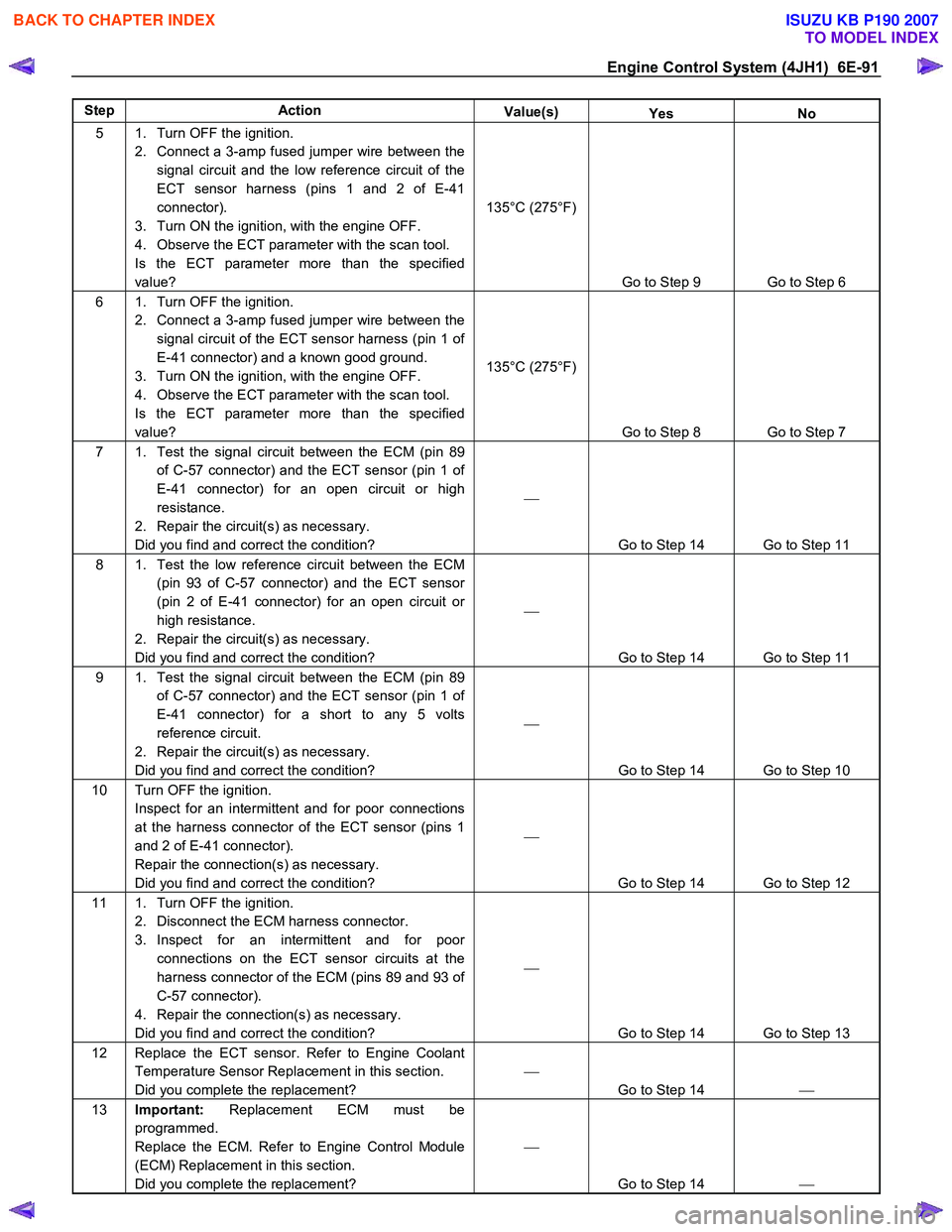
Engine Control System (4JH1) 6E-91
Step Action Value(s) Yes No
5 1. Turn OFF the ignition.
2. Connect a 3-amp fused jumper wire between the signal circuit and the low reference circuit of the
ECT sensor harness (pins 1 and 2 of E-41
connector).
3. Turn ON the ignition, with the engine OFF.
4. Observe the ECT parameter with the scan tool.
Is the ECT parameter more than the specified
value? 135°C (275°F)
Go to Step 9 Go to Step 6
6 1. Turn OFF the ignition. 2. Connect a 3-amp fused jumper wire between the signal circuit of the ECT sensor harness (pin 1 of
E-41 connector) and a known good ground.
3. Turn ON the ignition, with the engine OFF.
4. Observe the ECT parameter with the scan tool.
Is the ECT parameter more than the specified
value? 135°C (275°F)
Go to Step 8 Go to Step 7
7 1. Test the signal circuit between the ECM (pin 89 of C-57 connector) and the ECT sensor (pin 1 of
E-41 connector) for an open circuit or high
resistance.
2. Repair the circuit(s) as necessary.
Did you find and correct the condition?
Go to Step 14 Go to Step 11
8 1. Test the low reference circuit between the ECM (pin 93 of C-57 connector) and the ECT sensor
(pin 2 of E-41 connector) for an open circuit or
high resistance.
2. Repair the circuit(s) as necessary.
Did you find and correct the condition?
Go to Step 14 Go to Step 11
9 1. Test the signal circuit between the ECM (pin 89 of C-57 connector) and the ECT sensor (pin 1 of
E-41 connector) for a short to any 5 volts
reference circuit.
2. Repair the circuit(s) as necessary.
Did you find and correct the condition?
Go to Step 14 Go to Step 10
10 Turn OFF the ignition. Inspect for an intermittent and for poor connections
at the harness connector of the ECT sensor (pins 1
and 2 of E-41 connector).
Repair the connection(s) as necessary.
Did you find and correct the condition?
Go to Step 14 Go to Step 12
11 1. Turn OFF the ignition. 2. Disconnect the ECM harness connector.
3. Inspect for an intermittent and for poor connections on the ECT sensor circuits at the
harness connector of the ECM (pins 89 and 93 of
C-57 connector).
4. Repair the connection(s) as necessary.
Did you find and correct the condition?
Go to Step 14 Go to Step 13
12 Replace the ECT sensor. Refer to Engine Coolant Temperature Sensor Replacement in this section.
Did you complete the replacement?
Go to Step 14
13 Important: Replacement ECM must be
programmed.
Replace the ECM. Refer to Engine Control Module
(ECM) Replacement in this section.
Did you complete the replacement?
Go to Step 14
BACK TO CHAPTER INDEX
TO MODEL INDEX
ISUZU KB P190 2007
Page 1126 of 6020
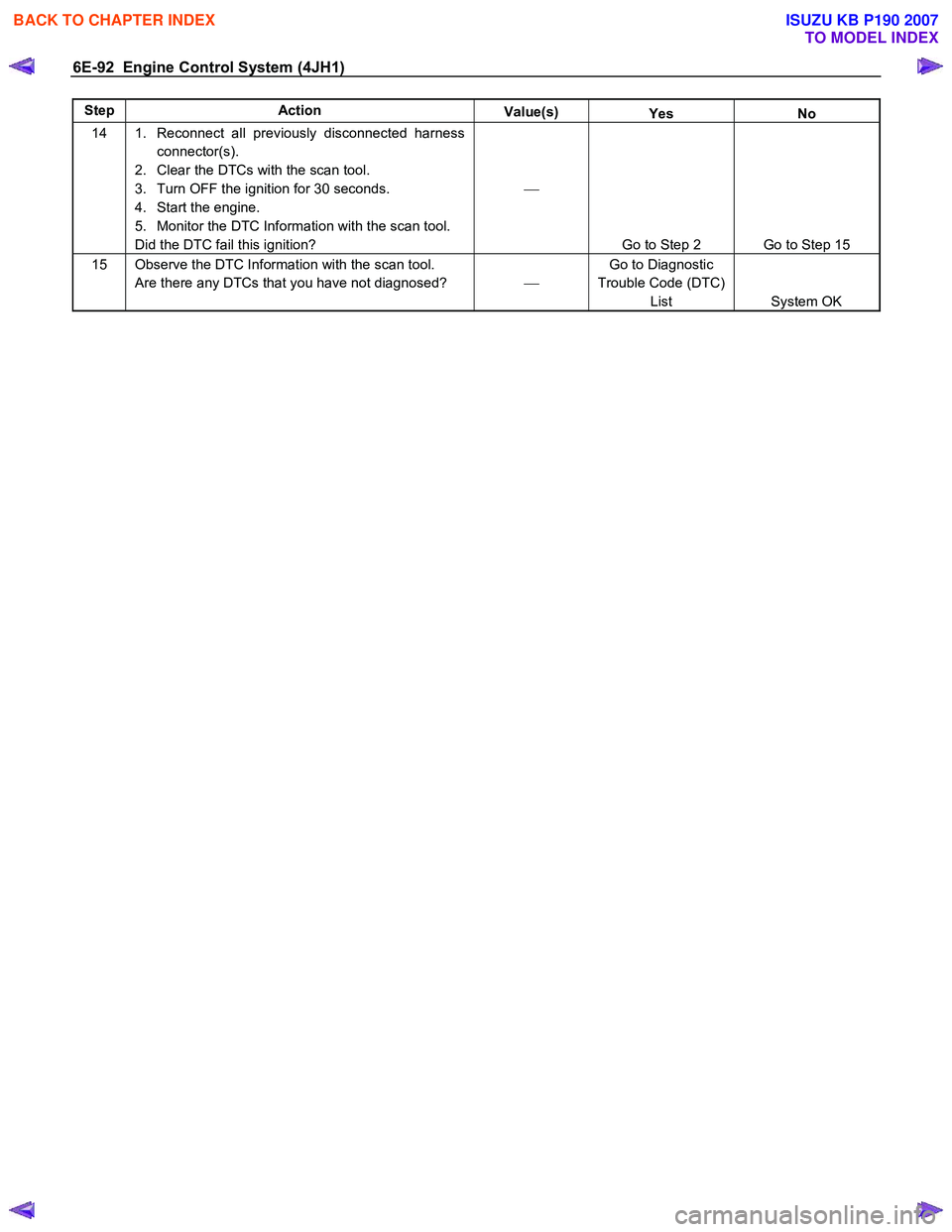
6E-92 Engine Control System (4JH1)
Step Action Value(s) Yes No
14 1. Reconnect all previously disconnected harness
connector(s).
2. Clear the DTCs with the scan tool.
3. Turn OFF the ignition for 30 seconds.
4. Start the engine.
5. Monitor the DTC Information with the scan tool.
Did the DTC fail this ignition?
Go to Step 2 Go to Step 15
15 Observe the DTC Information with the scan tool. Are there any DTCs that you have not diagnosed? Go to Diagnostic
Trouble Code (DTC) List System OK
BACK TO CHAPTER INDEX
TO MODEL INDEX
ISUZU KB P190 2007
Page 1127 of 6020
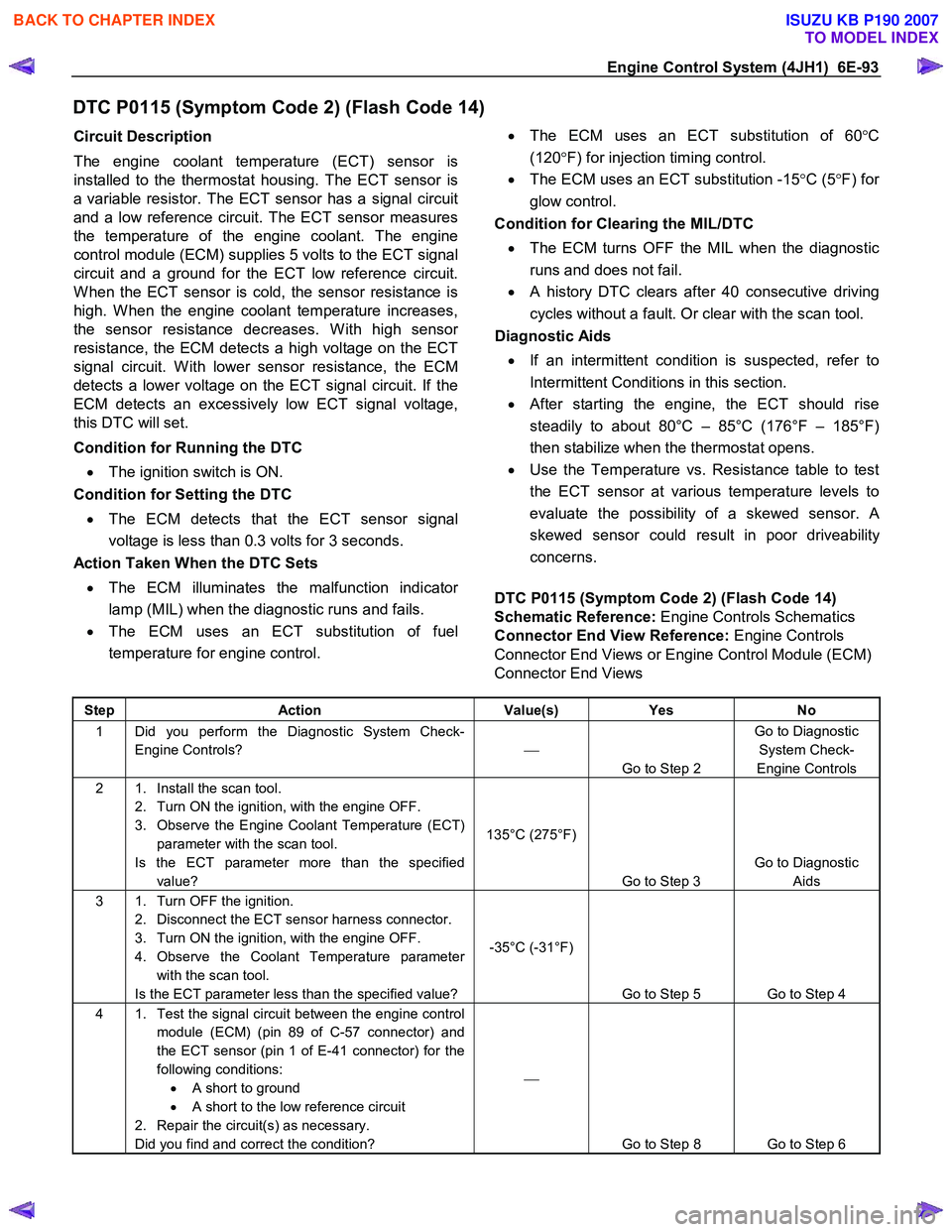
Engine Control System (4JH1) 6E-93
DTC P0115 (Symptom Code 2) (Flash Code 14)
Circuit Description
The engine coolant temperature (ECT) sensor is
installed to the thermostat housing. The ECT sensor is
a variable resistor. The ECT sensor has a signal circuit
and a low reference circuit. The ECT sensor measures
the temperature of the engine coolant. The engine
control module (ECM) supplies 5 volts to the ECT signal
circuit and a ground for the ECT low reference circuit.
W hen the ECT sensor is cold, the sensor resistance is
high. W hen the engine coolant temperature increases,
the sensor resistance decreases. W ith high senso
r
resistance, the ECM detects a high voltage on the ECT
signal circuit. W ith lower sensor resistance, the ECM
detects a lower voltage on the ECT signal circuit. If the
ECM detects an excessively low ECT signal voltage,
this DTC will set.
Condition for Running the DTC
• The ignition switch is ON.
Condition for Setting the DTC
• The ECM detects that the ECT sensor signal
voltage is less than 0.3 volts for 3 seconds.
Action Taken When the DTC Sets
• The ECM illuminates the malfunction indicato
r
lamp (MIL) when the diagnostic runs and fails.
• The ECM uses an ECT substitution of fuel
temperature for engine control.
•
The ECM uses an ECT substitution of 60 °C
(120 °F) for injection timing control.
• The ECM uses an ECT substitution -15 °C (5 °F) fo
r
glow control.
Condition for Clearing the MIL/DTC
• The ECM turns OFF the MIL when the diagnostic
runs and does not fail.
• A history DTC clears after 40 consecutive driving
cycles without a fault. Or clear with the scan tool.
Diagnostic Aids
• If an intermittent condition is suspected, refer to
Intermittent Conditions in this section.
•
After starting the engine, the ECT should rise
steadily to about 80°C – 85°C (176°F – 185°F)
then stabilize when the thermostat opens.
• Use the Temperature vs. Resistance table to test
the ECT sensor at various temperature levels to
evaluate the possibility of a skewed sensor.
A
skewed sensor could result in poor driveabilit
y
concerns.
DTC P0115 (Symptom Code 2) (Flash Code 14)
Schematic Reference: Engine Controls Schematics
Connector End View Reference: Engine Controls
Connector End Views or Engine Control Module (ECM)
Connector End Views
Step Action Value(s) Yes No
1 Did you perform the Diagnostic System Check-
Engine Controls?
Go to Step 2 Go to Diagnostic
System Check-
Engine Controls
2 1. Install the scan tool. 2. Turn ON the ignition, with the engine OFF.
3. Observe the Engine Coolant Temperature (ECT) parameter with the scan tool.
Is the ECT parameter more than the specified value? 135°C (275°F)
Go to Step 3 Go to Diagnostic
Aids
3 1. Turn OFF the ignition. 2. Disconnect the ECT sensor harness connector.
3. Turn ON the ignition, with the engine OFF.
4. Observe the Coolant Temperature parameter with the scan tool.
Is the ECT parameter less than the specified value? -35°C (-31°F)
Go to Step 5 Go to Step 4
4 1. Test the signal circuit between the engine control module (ECM) (pin 89 of C-57 connector) and
the ECT sensor (pin 1 of E-41 connector) for the
following conditions: • A short to ground
• A short to the low reference circuit
2. Repair the circuit(s) as necessary.
Did you find and correct the condition?
Go to Step 8 Go to Step 6
BACK TO CHAPTER INDEX
TO MODEL INDEX
ISUZU KB P190 2007
Page 1128 of 6020
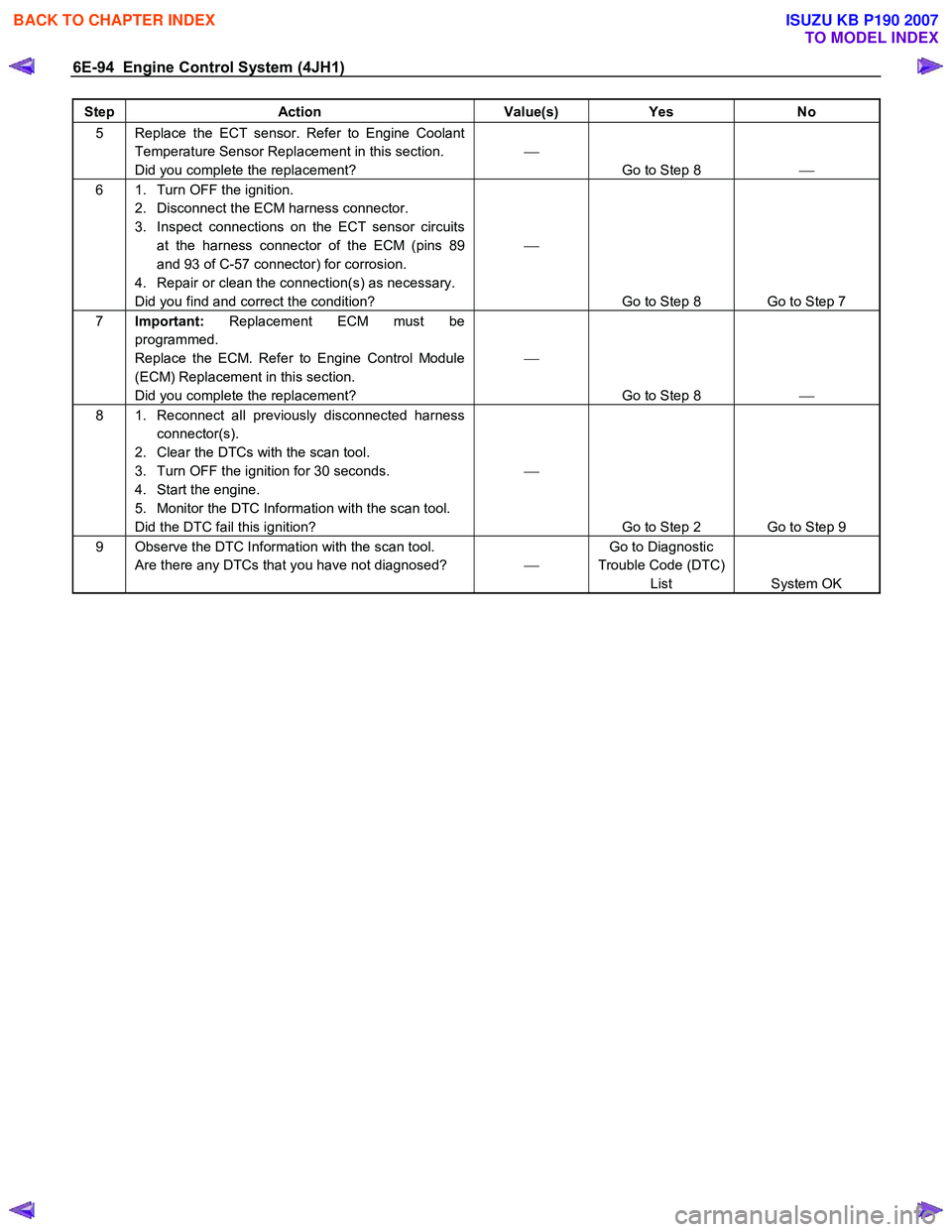
6E-94 Engine Control System (4JH1)
Step Action Value(s) Yes No
5 Replace the ECT sensor. Refer to Engine Coolant
Temperature Sensor Replacement in this section.
Did you complete the replacement?
Go to Step 8
6 1. Turn OFF the ignition.
2. Disconnect the ECM harness connector.
3. Inspect connections on the ECT sensor circuits at the harness connector of the ECM (pins 89
and 93 of C-57 connector) for corrosion.
4. Repair or clean the connection(s) as necessary.
Did you find and correct the condition?
Go to Step 8 Go to Step 7
7 Important: Replacement ECM must be
programmed.
Replace the ECM. Refer to Engine Control Module
(ECM) Replacement in this section.
Did you complete the replacement?
Go to Step 8
8 1. Reconnect all previously disconnected harness
connector(s).
2. Clear the DTCs with the scan tool.
3. Turn OFF the ignition for 30 seconds.
4. Start the engine.
5. Monitor the DTC Information with the scan tool.
Did the DTC fail this ignition?
Go to Step 2 Go to Step 9
9 Observe the DTC Information with the scan tool. Are there any DTCs that you have not diagnosed? Go to Diagnostic
Trouble Code (DTC) List System OK
BACK TO CHAPTER INDEX
TO MODEL INDEX
ISUZU KB P190 2007
Page 1129 of 6020

Engine Control System (4JH1) 6E-95
DTC P0180 (Symptom Code B) (Flash Code 15)
Circuit Description
The fuel temperature (FT) sensor is internal to the fuel
injection pump control unit (PCU). It detects fuel
temperature in the fuel injection pump. The engine
control module (ECM) and PCU communicates with
each other over the controller area network (CAN) link.
If the PCU internal FT sensor output is an excessivel
y
high or low, this DTC will set.
Condition for Running the DTC
• The ignition switch is ON.
Condition for Setting the DTC
• The PCU internal FT sensor output is lower than -
40°C (-40°F) for 3 seconds or higher than 150°C
(302°F) for 3 seconds.
Action Taken When the DTC Sets
• The ECM illuminates the malfunction indicato
r
lamp (MIL) when the diagnostic runs and fails.
•
The ECM uses a default FT substitution for engine
control.
Condition for Clearing the MIL/DTC
• The ECM turns OFF the MIL when the diagnostic
runs and does not fail.
• A history DTC clears after 40 consecutive driving
cycles without a fault. Or clear with the scan tool.
Diagnostic Aids
• If an intermittent condition is suspected, refer to
Intermittent Conditions in this section.
Notice:
• FT sensor is internal to the PCU and it is part o
f
the fuel injection pump assembly.
DTC P0180 (Symptom Code B) (Flash Code 15)
Step Action Value(s) Yes No
1 Did you perform the Diagnostic System Check-
Engine Controls?
Go to Step 2 Go to Diagnostic
System Check-
Engine Controls
2 1. Install the scan tool. 2. Turn OFF the ignition for 30 seconds.
3. Start the engine.
4. Monitor the Diagnostic Trouble Code (DTC) Information with the scan tool.
Does the DTC fail this ignition?
Go to Step 3 Go to Step 4
3 Important: The fuel injection pump must be timed to
the engine.
Replace the fuel injection pump. Refer to Fuel
Injection Pump Replacement in engine mechanical
section. (Fuel temperature (FT) sensor is internal to
the fuel injection pump control unit (PCU) and it is
part of the fuel injection pump assembly.)
Did you complete the replacement?
Go to Step 4
4 1. Clear the DTCs with the scan tool.
2. Turn OFF the ignition for 30 seconds.
3. Start the engine.
4. Monitor the DTC Information with the scan tool.
Did the DTC fail this ignition?
Go to Step 3 Go to Step 5
5 Observe the DTC Information with the scan tool. Are there any DTCs that you have not diagnosed? Go to Diagnostic
Trouble Code (DTC) List System OK
BACK TO CHAPTER INDEX
TO MODEL INDEX
ISUZU KB P190 2007
Page 1130 of 6020

6E-96 Engine Control System (4JH1)
DTC P0215 (Symptom Code A) (Flash Code 52)
Circuit Description
The engine control module (ECM) calculates the
desired fuel injection quantity and timing using data sent
from various sensors. These desired data are sent to
the fuel injection pump control unit (PCU) via a
controller area network (CAN) communication bus. The
PCU also receives signals from the internal inputs:
pump camshaft position (CMP) sensor that is located
inside the fuel injection pump to determine the cam ring
rotation angle and the fuel injection pump speed. The
fuel temperature (FT) sensor is internal the PCU. These
values are used to compare the desired values sent
from the ECM then PCU determines the injection time
r
piston position and fuel injection quantity, and actuates
timing control valve (TCV) & fuel injection solenoid
valve based on control maps in the PCU.
The fuel injection solenoid valve is installed to the fuel
injection pump rear side. The fuel injection event is
determined by this solenoid ON/OFF command. The
fuel injection solenoid valve cuts the fuel when the
engine shutoff (ESO) solenoid valve is commanded
shutoff from the PCU. (The fuel injection solenoid valve
and engine shutoff (ESO) solenoid valve is same part. It
calls ESO solenoid valve when fuel is shutoff.) W hen
the ignition switch is turned OFF or commanded from
fail-safe action, the ESO solenoid valve is commanded
shutoff to stop the engine running. If the ECM detects
that the engine is continuously run after the ignition
switch is OFF, this DTC will set.
Condition for Running the DTC
• The ignition switch is OFF.
• The engine speed is lower than 1500 RPM.
• The vehicle speed is lower than 1.5 km/h (1 MPH).
Condition for Setting the DTC
•
After the condition for running this DTC for 2
seconds, the engine speed is higher than 200
RPM when the ESO solenoid valve is commanded
shutoff from the CPU. This indicates the PCU
reacts to the command from the ECM but ESO
solenoid valve does not react to the command
from the PCU and fuel cannot shutoff.
Action Taken When the DTC Sets
• The ECM illuminates the malfunction indicato
r
lamp (MIL) at next ignition cycle.
• The ECM cuts fuel injection.
Condition for Clearing the MIL/DTC
• The ECM turns OFF the MIL when the diagnostic
runs and does not fail.
• A history DTC clears after 40 consecutive driving
cycles without a fault. Or clear with the scan tool.
Diagnostic Aids
• If an intermittent condition is suspected, refer to
Intermittent Conditions in this section.
Notice:
• Fuel injection solenoid valve is internal to the fuel
injection pump assembly.
• PCU is part of the fuel injection pump assembly.
DTC P0215 (Symptom Code A) (Flash Code 52)
Step Action Value(s) Yes No
1 Did you perform the Diagnostic System Check-
Engine Controls?
Go to Step 2 Go to Diagnostic
System Check-
Engine Controls
2 1. Install the scan tool. 2. Turn OFF the ignition for 30 seconds.
3. Start the engine and let idle for 30 seconds.
4. Monitor the Diagnostic Trouble Code (DTC) Information with the scan tool.
5. Turn OFF the engine.
Does the DTC fail this ignition before the engine
control module (ECM) turned OFF?
Go to Step 3 Go to Step 4
3 Important: The fuel injection pump must be timed to
the engine.
Replace the fuel injection pump. Refer to Fuel
Injection Pump Replacement in engine mechanical
section.
Did you complete the replacement?
Go to Step 4
BACK TO CHAPTER INDEX
TO MODEL INDEX
ISUZU KB P190 2007
Page 1131 of 6020
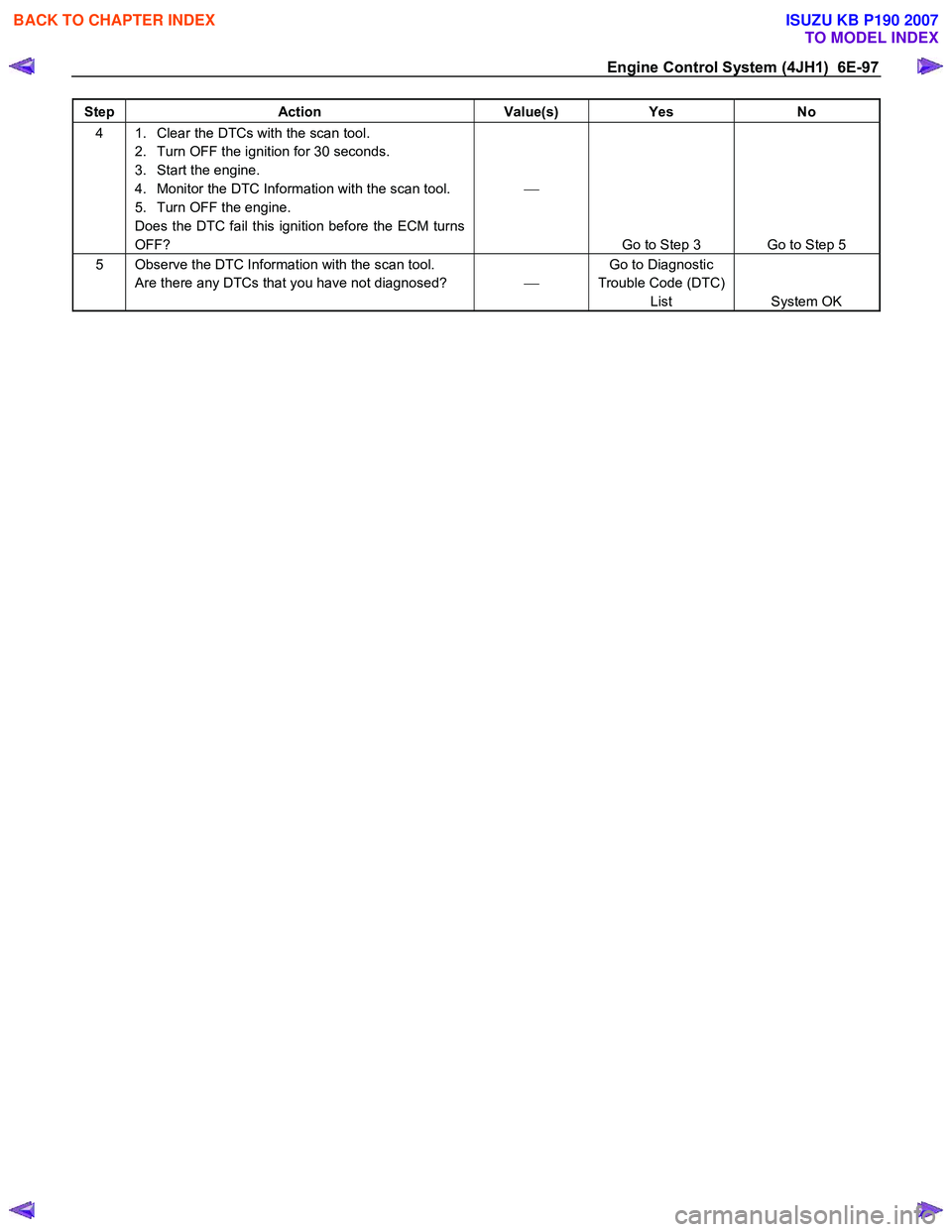
Engine Control System (4JH1) 6E-97
Step Action Value(s) Yes No
4 1. Clear the DTCs with the scan tool.
2. Turn OFF the ignition for 30 seconds.
3. Start the engine.
4. Monitor the DTC Information with the scan tool.
5. Turn OFF the engine.
Does the DTC fail this ignition before the ECM turns
OFF?
Go to Step 3 Go to Step 5
5 Observe the DTC Information with the scan tool. Are there any DTCs that you have not diagnosed? Go to Diagnostic
Trouble Code (DTC) List System OK
BACK TO CHAPTER INDEX
TO MODEL INDEX
ISUZU KB P190 2007